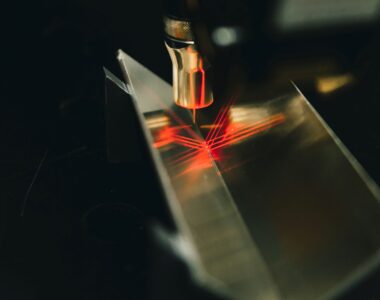Automation of processes in industrial manufacturing – giving the robot an eye
09. Sep 2023

The use of modern robots and automated systems enables companies to produce more efficiently and increase their productivity. The shortage of skilled workers is giving this development a further boost. However, positioning or component tolerances are a constant problem, especially in automated production with high volumes. These inaccuracies must be detected and compensated for in order to avoid expensive scrap or downtime.
Sensors for optical seam tracking help guide the robot arm along the desired seam. By capturing optical information, they can detect deviations in edge offset and automatically report them back. They give the robot an eye, so to speak. This significantly increases the accuracy and efficiency of machines and production lines. The precision and efficiency of a sensor depend crucially on the quality of the optical system, the performance of the image processing processor and the accuracy of the control algorithms. The conditions of automated series production with the corresponding mechanical stress on the tools at high volumes also place high demands on its robustness.
TH6D-Advanced: for precise seam tracking and more productivity
Scansonic offers mature solutions with its TH6x sensor product family, already proven with 1,500 units installed in the field. In developing its latest sensor, the TH6D-Advanced, Scansonic placed great emphasis on extremely powerful image processing and scalable pattern recognition algorithms. The TH6D-Avanced is suitable for applications in the field of automated welding processes with arc or laser, as well as for automated gluing or other processes where precise and reliable guidance along a defined geometry is required.
The basis of image processing in the TH6D-Advanced is the proven triangulation principle. Components and various joints are detected by a combination of laser lines, a powerful camera and an optical system that gives the TH6D-Advanced a resolution of 25 μm. Using the light-sectioning method, the sensor projects three lines onto the edge to be machined. These lines refract at the edge and pass on information about the seam position, gap dimension and edge offset at the joint to the control system, as well as correction data for the orientation and positioning of the tool. Unlike most other systems, all Scansonic sensors, including the TH6D-Advanced, operate with three lines. This redundancy significantly increases the reliability of the information supplied, thus supporting a stable process.
In this way, the TH6D-Advanced allows dynamic correction of the Tool Center Point (TCP) in real time. This permanent tuning also eliminates the need for time-consuming re-teaching when changing parts or changes in the edge (in x, y and z).
Integrated stray light filtering ensures smooth operation
Scansonic’s proprietary software is at the heart of the sensor system. This includes integrated stray light filtering, which enables the sensor to deliver reliable results even under difficult lighting conditions. For example, different materials such as aluminum or carbon fiber-reinforced plastics (CFRP) show strongly deviating absorption and reflection behavior of the projected light lines. And even in difficult processes such as T-joints in conjunction with reflective surfaces, seam detection is reliable. In this case, reflections of the lines occur, creating a grid structure. The system’s software evaluates ambiguous signals and calculates out most of the reflection. Optical filters also make the system insensitive to interfering light.
Customer-friendly flexible and robust
The new TH6D-Advanced is suitable for robots as well as axis systems, it enables a wide range of applications, recognizes all common seam shapes and can be used for all materials that can be joined or separated such as steel, stainless steel, aluminum, plastics or wood. Extremely user-friendly, the software supplied is quickly installed and easy to use. The customer can easily adapt it to his own individual processes and specific seam geometry.
The new system also proves itself under the conditions of highly automated series production thanks to its robust design. It is insensitive to the influence of electrical interference. The housing is splash-proof and features an integrated protective glass rinsing system and a protective glass quick-change unit. An integrated air cooling system ensures constant temperatures.
This makes the new system ideal for both small and medium-sized companies that want to automate their joining processes or improve existing ones. The sensor is also already scoring points in the automotive industry, where the highest demands are placed on accuracy and perfect seams in series production. Scansonic’s experience provides users from industry with a valuable basis for optimizing their own manufacturing processes.
